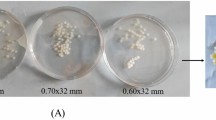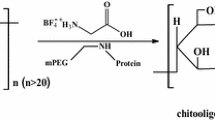Abstract
An effective approach to the stabilization of hydrolytic enzymes (alkaline proteinase and cellulases) via the complex formation with chitosan for their further use as detergent components has been developed. Interaction with chitosan results in a 35–50% increase in the level of catalytic activity of the enzymes after incubation for 60 min under the conditions of detergent use (alkaline pH, increased temperature, the presence of anionic surfactants) as compared to the system in the absence of chitosan both due to the enzyme stabilization and the increase of the starting level of catalytic activity. A twofold decrease of the enzyme inactivation constant is observed under the aforementioned conditions in the case of alkaline proteinase. In the case of cellulase preparation, the method for the control of the concentration of the active enzyme in the system modeling synthetic detergents has been suggested. The method is based on the enzymatic destruction of the stabilizing agent, chitosan, by enzymes of the cellulase complex. The destruction of chitosan removed the stabilizing effect, thus resulting in the inactivation of cellulases. The developed approaches allow for the widening of the field of the possible application of enzymes as detergent components.
Similar content being viewed by others
Abbreviations
- Cht:
-
chitosan
- CM:
-
cellulose, carboxymethylcellulose
- LAS:
-
linear alkyl sulfate
- PE:
-
polyelectrolyte
- TCA:
-
trichloroacetic acid
References
Van Den Bergh, C., Kaiserman, H.B., and Ouwendijk, M., Biotech. Adv., 1997, vol. 15, pp. 210–215.
Moreira, K.A., Albuquerque, B.F., Teixeira, M.F.S., Porto, A.L.F., and Lima Filho, J.L., World J. Microb. Biotech., 2002, vol. 18, pp. 309–315.
Kudryashova, E.V., Gladilin, A.K., and Levashov, A.V., Usp. Biol. Khim., 2002, vol. 42, pp. 257–294.
Kudryashova, E.V., Gladilin, A.K., Izumrudov, V.A., van Hoek, A., Visser, A.J.W.G., and Levashov, A.V., Biochim. Biophys. Acta, 2001, vol. 1550, pp. 129–143.
Kudryashova, E.V., Gladilin, A.K., Vakurov, A.V., Heitz, F., Levashov, A.V., and Mozhaev, V.V., Biotech. Bioengin., 1997, vol. 55, pp. 267–277.
Jeon, Y.-J., Park, P.-J., and Kim, S.-K., Carbohydrate, 2001, vol. 44, pp. 71–76.
Uchida, Y, Izume, M, and Ohtakara, A, in Chitin and Chitosan: Chemistry, Biochemistry, Physical Properties and Applications, Skjak, G., Anthonsen, T., and Sandford, P., Eds., London: Elsevier, 1989.
Merzendorfer, H. and Zimoch, L., J. Exp. Biol., 2003, vol. 206, pp. 4393–4412.
Rabea, E.I., Badawy, M.E.T., Stevens, C.V., Smagghe, G., and Steurbaut, W., Appl. Mode Biomacromol., 2003, vol. 4, pp. 1457–1465.
Tikhonov, V.E., Stepnova, E.A., Babak, V.G., Yamskov, I.A., Palma-Guerrero, J., Jansson, H.-B., Lopez-Llorca, L.V., Salinas, J., Gerasimenko, D.V., Avdienko, I.D., and Varlamov, V.P., Carbohydr. Polymers, 2006, vol. 64, pp. 66–72.
Kendra, D.F. and Hadwiser, L.A., Exp. Mycol., 1984, vol. 8, pp. 276–281.
Hirano, S. and Nagao, N., Agricult. Chem., 1989, vol. 53, pp. 3065–3066.
Chirkov, S.N., Applied Biochem. Microbiol., 2002, vol. 38, pp. 1–8.
Zorov, I.N., Sinitsyn, A.P., and Kondrat’eva, E.G., Prikl. Biokhim. Mikrobiol., 2006, vol. 42, pp. 705–709.
Grishutin, S.G., Gusakov, A.V., Markov, A.V., Ustinov, B.B., Semenova, M.V., and Sinitsyn, A.P., Biochim. Biophys. Acta, 2004, vol. 1674, pp. 268–281.
Sterchi, E.E. and Stocker, W., Proteolytic Enzymes. Tools and Targets, Berlin: Springer Lab. Manual, 1999, pp. 12–13.
Sinitsyn, A.P., Gusakov, A.V., and Chernoglazov, V.M., Biokonversiya ligno-tsellyuloznykh materialov (Bioconversion of Lignin-Cellulose Materials), Moscow: Mosk. Gos. Univ., 1995.
Author information
Authors and Affiliations
Corresponding author
Additional information
Original Russian Text © E.V. Kudryashova, I.S. Vasil’eva, I.N. Zorov, A.P. Sinitsyn, A.V. Levashov, 2009, published in Bioorganicheskaya Khimiya, 2009, Vol. 35, No. 3, pp. 368–375.
Rights and permissions
About this article
Cite this article
Kudryashova, E.V., Vasil’eva, I.S., Zorov, I.N. et al. Stabilization of alkaline proteinase and cellulases via complex formation with chitosan for use as detergent components. Russ J Bioorg Chem 35, 335–341 (2009). https://doi.org/10.1134/S106816200903008X
Received:
Accepted:
Published:
Issue Date:
DOI: https://doi.org/10.1134/S106816200903008X




